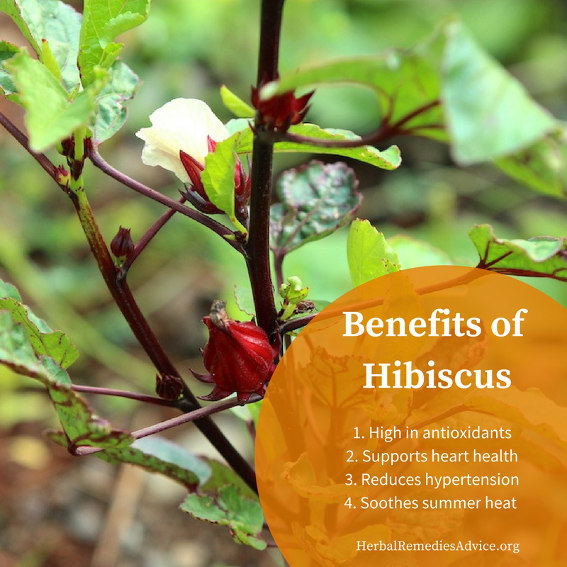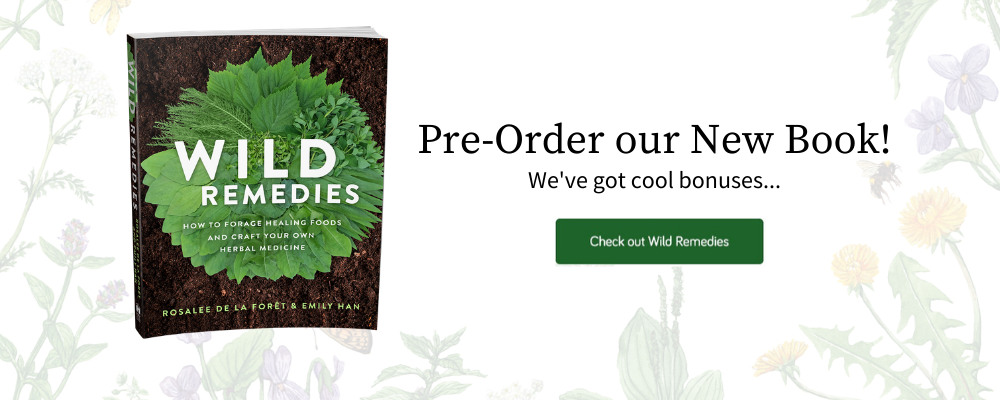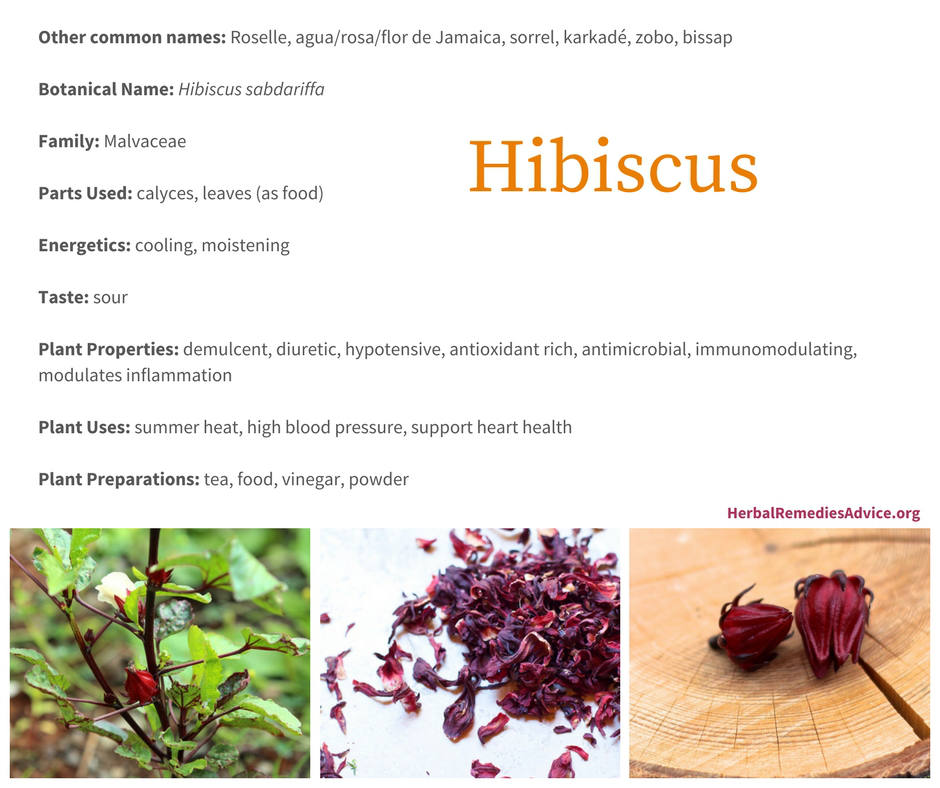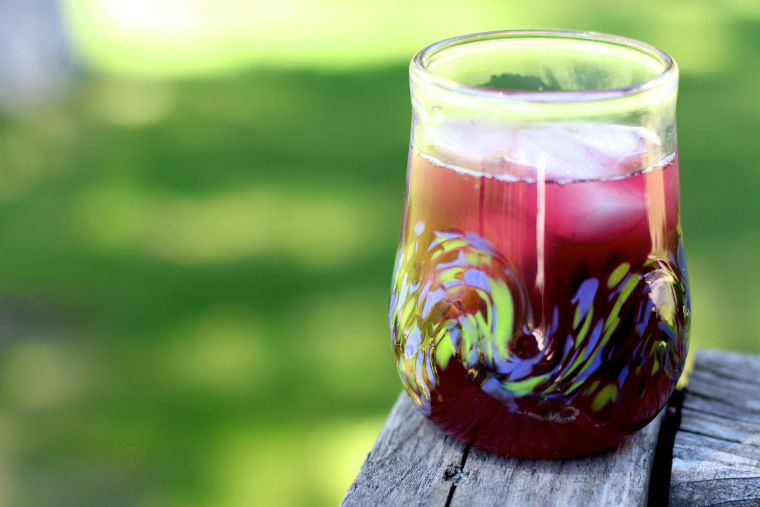Get weekly tips, recipes, and my Herbal Jumpstart e-course! Sign up for free today.

Benefits of Hibiscus
Share this! |
|
Tangy and tart with a hint of sweetness, the benefits of hibiscus tea include being a refreshing and soothing drink during hot summer months. Like many of its relatives in the mallow family, Hibiscus is demulcent, coating mucus membranes that can easily be parched in arid climates.
Members of the Hibiscus genus have long been loved by humans. It’s estimated that people have been growing Hibiscus sabdariffa for about 6,000 years! Hibiscus probably originated in northern Africa but, since it has been tended for so long, it now grows throughout the tropical and subtropical world and it is impossible to definitively know its origins. It has been used as food and medicine in India for thousands of years.
Members of the Hibiscus genus are widely used as food, beverage, medicine, and even for their fibers. Hibiscus has recently gained popularity in the western world due to its benefits for the cardiovascular system and metabolism.
Benefits of Hibiscus for the Cardiovascular System and Metabolism
Hibiscus has been used throughout the world for its heart related benefits. When I was traveling in the Yucatan of Mexico, I was repeatedly told that “agua de Jamaica” (hibiscus tea) was good for both the heart and type 2 diabetes. Hibiscus tea was readily found at restaurants and street venders and the dried calyces were sold in large bags at local markets.
Research findings suggest that certain polyphenols in hibiscus benefit mitochondrial function, energy homeostasis, and protection of the cardiovascular system. These effects can mean beneficial changes in inflammation, endothelial dysfunction, and oxidation, which are often related to heart health.1
Hibiscus has been studied by researchers in recent years; however, most of the studies to date are in vitro or done on animals. Here’s a look at some of the positive human clinical trials.
Both hibiscus tea and green tea were shown to significantly decrease systolic and diastolic blood pressure in individuals who had been diagnosed with type 2 diabetes and were mildly hypertensive.2
In one trial, 40 adult patients with metabolic syndrome were either given 500mg of hibiscus calyx powder or a placebo. After four weeks, those taking the hibiscus powder had significantly reduced triglycerides and reduced systolic blood pressure compared to those taking the placebo.3
In addition to benefiting people with high blood pressure, hibiscus extracts have been shown to positively affect blood lipids by reducing total cholesterol and triglyceride levels.4,5,6
In another small study, hibiscus was shown to be more effective than a commonly prescribed diuretic for lowering blood pressure.7
In one trial conducted on 54 male soccer players, hibiscus tea extract was shown to decrease negative oxidative stress and increase total antioxidant capacity.8
Chronic high blood pressure can negatively affect the kidneys. A study in Nigeria showed that hibiscus had beneficial effects for 78 people with newly diagnosed but untreated mild to moderate hypertension. Compared to a group taking lisinopril (an ACE inhibitor) and placebo, those taking hibiscus had increased urine volume and increased creatinine clearance. The study concluded that hibiscus improves kidney function in susceptible populations.9
When using hibiscus for heart health, a review from the American Botanical Council concluded that “The effects of hibiscus on blood lipids and hypertension seem to be dose and duration dependent. Higher doses over longer periods of time appear to be the most effective.”10
Hibiscus Benefits for the Summer Heat
Hibiscus has a sour taste that quenches summer thirst; thus, another common name for the tea in the Caribbean is “sorrel,” meaning sour. It’s also high in mucilage, making it ideal for heat with dryness. I rely on hibiscus throughout the arid summer months and have found it to be especially beneficial when there are smoky skies due to wildfires. In addition to being refreshing and demulcent, the high antioxidants are beneficial companions to mitigate the oxidative stress brought on by excessive smoke inhalation. I like to combine hibiscus with mint family members – such as peppermint or tulsi (holy basil) – and other demulcents like mallow and oatstraw.
A traditional use for hibiscus in the Caribbean was as a cooling tea for summer heat, combined with peppermint and lemongrass. This traditional formula became the inspiration for the popular “Red Zinger” tea blend. In Trinidad and Tobago, hibiscus calyces are boiled with chopped ginger, clove, cinnamon, nutmeg, and sugar to make “sorrel,” which is traditionally drunk at Christmas and Chinese New Year, as well as year round.
Benefits of Hibiscus and Nutrients
Hibiscus calyces contain a variety of phytonutrients that are associated with modulating inflammation, including anthocyanins and flavonoids. They can also contain a significant quantity of polysaccharides, with 28% of the dry weight being attributed to mucilage.11
The calyces also contain Vitamin C, β-carotene, calcium, and iron.12 Hibiscus has traditionally been used to support healthy iron levels in people with anemia.
Benefits of Hibiscus for Cancer
In vitro studies suggest that hibiscus may have some beneficial effects against cancer. Hibiscus has been shown to inhibit cancer cell survival and increase apoptosis. Human clinical trials could shed more light on these effects.13,14,15
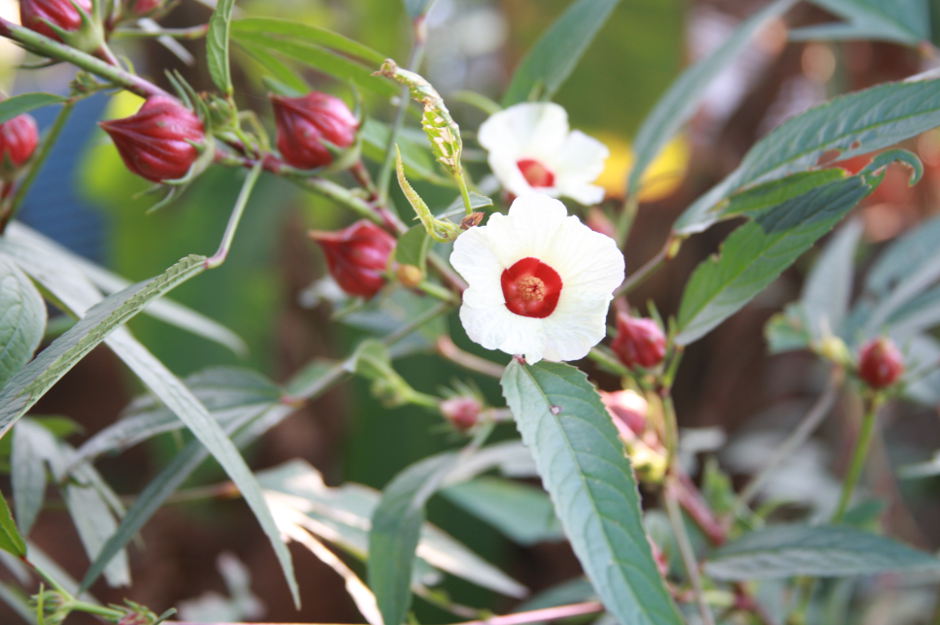 By Pradeepkannamkulath (Own work) [CC BY-SA 4.0 (https://creativecommons.org/licenses/by-sa/4.0)], via Wikimedia Commons
By Pradeepkannamkulath (Own work) [CC BY-SA 4.0 (https://creativecommons.org/licenses/by-sa/4.0)], via Wikimedia CommonsBenefits of Hibiscus: Global Hibiscus Uses
Hibiscus has a long history of use around the world, especially in subtropical and tropical locations where it will readily grow.
While the calyces are what are commonly found in the United States, the leaves, seeds, calyces, petals, and whole hibiscus flowers are used for both food and medicine.
The leaves are nutrient dense and contain high levels of iron and β-carotene. Hibiscus seeds are high in fat and protein, as well as several minerals, including potassium, calcium, and magnesium.
Various regions of India have a long history of using hibiscus in a variety of ways, including as a diuretic and for hypertension, chronic coughs, malaria, poisoning, dyspepsia, hemorrhoids, skin inflammations, and kidney stones.16
Hibiscus is also commonly used in numerous countries in northern Africa. Ethnobotany sources show that the leaves are used for their antimicrobial, emollient, antipyretic, diuretic, antihelminthic, and sedative properties.17
Benefits of Hibiscus: The Hibiscus Plant
Hibiscus sabdariffa is a member of the mallow family (Malvaceae). There are over 200 genera in this family and thousands of species, including several hundred species in the genus Hibiscus. Many of the plants in this family are used as demulcents in herbal medicine (Althea officinalis, Malva neglecta).
There are many plants that are commonly called hibiscus; however they are not interchangeable with Hibiscus sabdariffa. This botanical description is for Hibiscus sabdariffa.
Hibiscus sabdariffa is a shrub that grows up to eight feet tall in the tropics (smaller in temperate climates) and has white to yellow flowers and large edible calyces that can range in color from green to red to deep red to almost black, depending on the cultivar.
It grows as a perennial in zones 10-12 and as an annual in temperate climates.
The leaves grow alternately and are 3-5 inches long. The leaves are green with distinct reddish veins.
The flowers grow singly in the leaf axils. They can grow up to five inches wide and are whitish with a maroon center. The flowers turn pink as they wither.
The red calyx has five large sepals with pointed bracts at the bottom. Inside the calyx is a large green seed capsule that contains kidney-shaped brown seeds. The calyx is what is commonly used in teas.
The hibiscus plant requires a very long growing season; it does not flower and fruit until fall in subtropical regions (October in the northern hemisphere), thus the need for starting the seeds very early if you are growing hibiscus in a temperate climate.
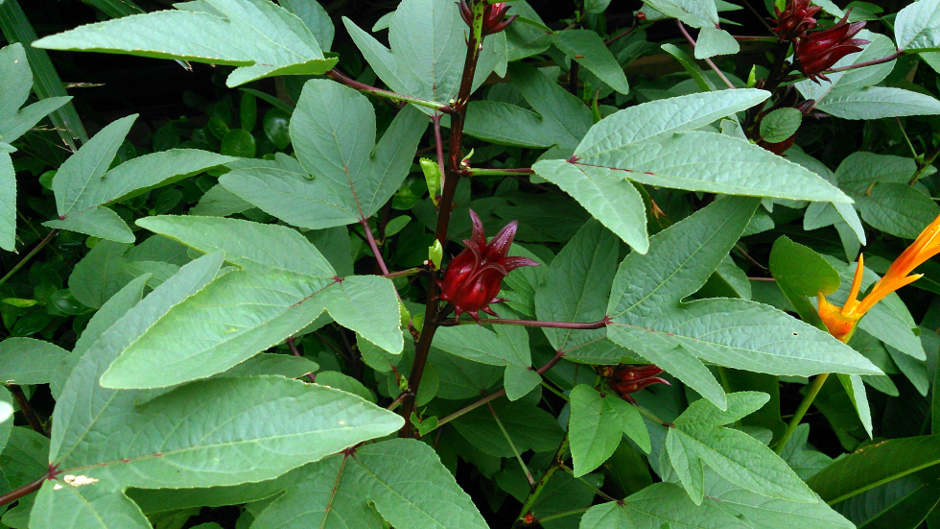 By Mokkie (Own work) [CC BY-SA 3.0 (https://creativecommons.org/licenses/by-sa/3.0)], via Wikimedia Commons
By Mokkie (Own work) [CC BY-SA 3.0 (https://creativecommons.org/licenses/by-sa/3.0)], via Wikimedia CommonsBenefits of Hibiscus: Growing Hibiscus
Last year was the first year I grew hibiscus. I live in USDA Plant Hardiness Zone 4, so this was an experiment for this subtropical plant. I had a very small harvest last year, but I learned a lot and am looking forward to trying again in the coming year.
Juliet Blankespoor, hibiscus and herb-growing aficionado, recommends that those in temperate climates grow a variety called Thai red Hibiscus, which can be found from Southern Exposure Seed Exchange.18
The seeds need to be started in a greenhouse or indoors at the same time you are starting tomatoes. The seeds need to be scarified (rubbed with sandpaper) for best germination.
Juliet recommends planting the seeds in a larger pot as they don’t transplant very well. I didn’t do this last year and they definitely suffered with the moves to larger pots. They can be transplanted to the garden once the danger of frost has passed. Hibiscus is very sensitive to frost.
After an individual hibiscus flower blooms, the petals die back and can easily be plucked from the calyx. The calyx can then be harvested. Inside the fresh calyx is a large green seed capsule (ovary). Last year I removed those before drying the calyces for tea. Juliet recommends chopping up the fresh calyx, including the seed capsule, and drying it all together. If you live in a humid environment it is not recommended to dry the calyx whole with the seed capsule intact as this makes it more susceptible to mold.
Benefits of Hibiscus: Hibiscus Preparations
In the Western world, hibiscus calyces are mostly used to make a refreshing tea. The calyces can also be used to make a variety of different drinks, foods, and desserts. In the late 1800s, Australia exported a lot of hibiscus jam to Europe. The calyces are commonly pickled in parts of India.
There is no recommended dosage for hibiscus as it is both food and medicine. Many studies used 500mg of hibiscus per day.
Hibiscus is not commonly used as an alcohol extract (tincture), because the mucilaginous components do not extract well in alcohol.
Hibiscus leaves are also used around the world both as food and for external healing applications.
Benefits of Hibiscus: Side Effects of Hibiscus
- The Botanical Safety Handbook recommends taking acetaminophen 3 hours away from taking hibiscus due to an increase in the elimination rate of the acetaminophen.19
- Hibiscus has mixed effects on the urinary excretion of diclofenac.20
- The American Botanical Council recommends caution when simultaneously using Hibiscus and antihypertensive drugs. “A hibiscus extract taken with the diuretic hydrochlorothiazide caused a significant increase in volume of urine excreted and decreased concentration of sodium, bicarbonate, chloride ions, and the pH of urine.”21
- Hibiscus may reduce the bioavailability of chloroquine.22
Citations for Benefits of Hibiscus
Click to show/hide.
Rosalee is an herbalist and author of the bestselling book Alchemy of Herbs: Transform Everyday Ingredients Into Foods & Remedies That Healand co-author of the bestselling book Wild Remedies: How to Forage Healing Foods and Craft Your Own Herbal Medicine. She's a registered herbalist with the American Herbalist Guild and has taught thousands of students through her online courses. Read about how Rosalee went from having a terminal illness to being a bestselling author in her full story here.
